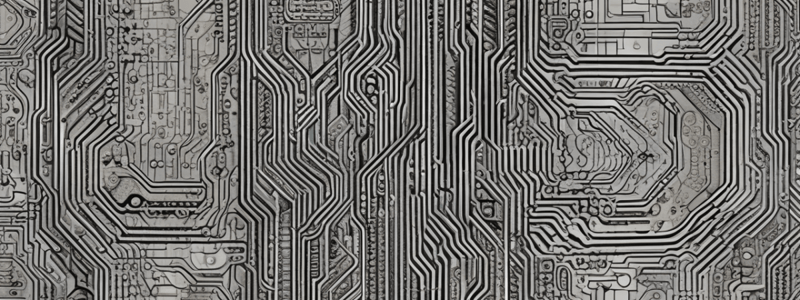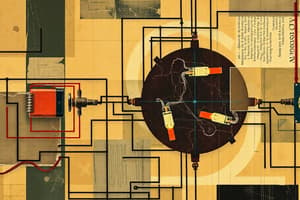Podcast
Questions and Answers
What stays the same throughout a series circuit regardless of where an ammeter is connected?
What stays the same throughout a series circuit regardless of where an ammeter is connected?
- The current flowing through the circuit (correct)
- The total power consumption
- The voltage drop across each component
- The resistance of the circuit
In a series circuit with identical bulbs and a 12-volt battery, what is the voltage measured across each bulb?
In a series circuit with identical bulbs and a 12-volt battery, what is the voltage measured across each bulb?
- 4 volts (correct)
- 12 volts
- 3 volts
- 6 volts
What happens to the current in a parallel circuit when it encounters a junction?
What happens to the current in a parallel circuit when it encounters a junction?
- It combines into a single path
- It decreases in total amount
- It splits between the branches (correct)
- It becomes zero in the branches
In a parallel circuit, what is the voltage across each bulb compared to the voltage of the battery?
In a parallel circuit, what is the voltage across each bulb compared to the voltage of the battery?
If the total current out of a battery is 6 amps in a parallel circuit with three branches, how much current flows through each branch?
If the total current out of a battery is 6 amps in a parallel circuit with three branches, how much current flows through each branch?
What characteristic is true about the current in a series circuit?
What characteristic is true about the current in a series circuit?
Which of the following statements about voltage in a series circuit is correct?
Which of the following statements about voltage in a series circuit is correct?
Which of the following describes the behavior of current in a circuit with branches?
Which of the following describes the behavior of current in a circuit with branches?
What is a key difference between series and parallel circuits concerning voltage?
What is a key difference between series and parallel circuits concerning voltage?
Which of the following best describes the flow of charge in a series circuit?
Which of the following best describes the flow of charge in a series circuit?
What is a characteristic of a series circuit?
What is a characteristic of a series circuit?
What device is used to measure the current in a circuit?
What device is used to measure the current in a circuit?
How is a voltmeter connected in a circuit experiment?
How is a voltmeter connected in a circuit experiment?
What happens to the current in a series circuit as more components are added?
What happens to the current in a series circuit as more components are added?
What is the purpose of connecting the ammeter in different parts of the series circuit?
What is the purpose of connecting the ammeter in different parts of the series circuit?
What type of circuit connects components on separate branches?
What type of circuit connects components on separate branches?
Which instrument would NOT typically be used in the described lab setup?
Which instrument would NOT typically be used in the described lab setup?
What is the effect of connecting bulbs in parallel on their brightness compared to a series connection?
What is the effect of connecting bulbs in parallel on their brightness compared to a series connection?
Why is it important to record readings from the ammeter and voltmeter?
Why is it important to record readings from the ammeter and voltmeter?
What is the main benefit of using a voltmeter in this experiment?
What is the main benefit of using a voltmeter in this experiment?
Flashcards are hidden until you start studying
Study Notes
Types of Electric Circuits
- Electric circuits are complete loops allowing electron flow from a voltage or current source.
- Two main types: series circuits and parallel circuits.
Series Circuits
- All components, including the battery, are connected in a single continuous loop.
- Current remains constant throughout; the same value is measured at any point in the circuit.
- Voltage is shared among the components; for example, with a 12-volt battery, three identical bulbs would receive 4 volts each.
Parallel Circuits
- Components are connected across separate branches, allowing multiple paths for current flow.
- The total current from the battery does not equal the current through each individual bulb; current splits at junctions.
- For three branches with a total current of 6 amps, each branch may have 2 amps flowing.
- Voltage remains consistent across each branch, with each bulb receiving the full voltage of the battery.
Physics Lab Steps
- Required Materials: Battery, three small bulbs, ten wires, ammeter, voltmeter.
- First setup: Connect battery, ammeter, and bulbs in series, with a voltmeter measuring one bulb.
- Obtain current and voltage measurements, then repeat measuring voltage across each bulb.
- Next setup: Connect battery and bulbs in parallel, with the ammeter next to the battery and voltmeter across bulbs.
- Record measurements similarly to the series circuit.
Data Analysis
- Analyze patterns in voltage and current from the collected data.
- In series circuits, observe consistent current flow and shared voltage across components.
- In parallel circuits, note how current splits among branches while voltage remains equal across each component.
Studying That Suits You
Use AI to generate personalized quizzes and flashcards to suit your learning preferences.




